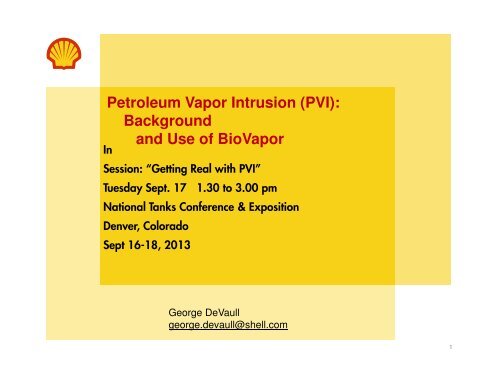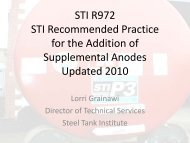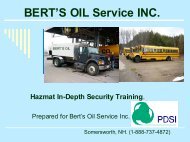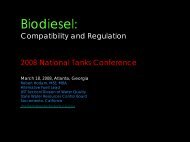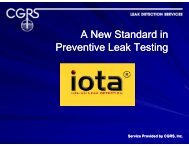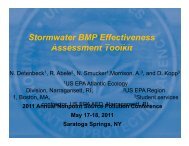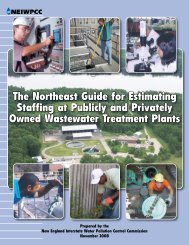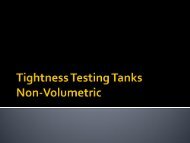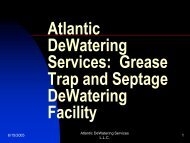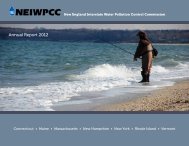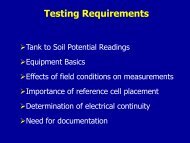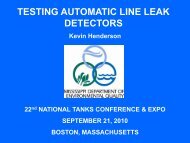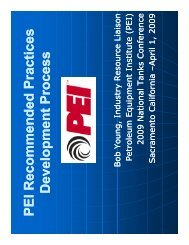DeVaull - NEIWPCC
DeVaull - NEIWPCC
DeVaull - NEIWPCC
Create successful ePaper yourself
Turn your PDF publications into a flip-book with our unique Google optimized e-Paper software.
Petroleum Hydrocarbons And Chlorinated HydrocarbonsDiffer In Their Potential For Vapor IntrusionUSEPA OUST 2011, www.epa.gov/oust/cat/pvi/pvicvi.pdfKEYPOINT:USEPA says that vapor intrusion risk is muchlower at petroleum sites.3
Vapor Flow: Barriers and LimitsBuildings Air exchange, positive pressure, backgroundBuilding Foundations Intact (no cracks or unsealed penetrations)Vadose Zone High soil moisture or clay (no vapor migration) Aerobic biodegradation Lateral offsetSource and Groundwater Clean water lens over source, Clay layers Finite source mass, Saturated vapor limitsConceptualModel:KEYPOINTS:• Much existing guidance is focused on building impacts.• Presence of a source does not always result in vapor intrusion.4
Basics – Introduction - PVITo Be Covered:Conceptual ModelsBiodegradationBuilding Foundations and Oxygen5
Petroleum VI - BiodegradationRegulation & guidance:US EPA. 2002. Draft Guidance . EPA/530/D-02/004US EPA. 2005. EPA/600/R-05/106.ITRC. 2007.US EPA. 2011.USEPA, 2013. OSWER Review DraftUSEPA, 2013, Guide for UST Sites.Others …KEYPOINT:Aerobic petroleum biodegradation is significant.6
Exponential Decay: Data Analysis & ScalingConcentration ntimespaceLτRR=⎛ R⎜i ⋅ H=⎝θw⋅ kDeffww⋅ Hθ ⋅ kiw⎞⎟⎠iSimple solutions (exponential decay)apply in some simplified geometriesOther solutions (algebraic, numerical)also used.Published and available ratesdefined or re-defined in terms of k w .θ w - soil moisture; k w - first-order waterphase rate; D eff - effective diffusioncoefficient, H - Henry’s law coefficient; R -soil/vapor partitionother conditions similar: aerobic throughout,readily degradable & bioavailable chemicals7
Results: Aerobic Petroleum Biodegradation Rates in SoilAromatic Hydrocarbonsk w = 0.48 /hr (0.08 to 3.0)k w = 40 /hr (7.8 to 205)Aliphatic Hydrocarbons8
Constraints on Kinetic Data and ApplicationTabulated Rates Okay for Most Vadose Zone SoilsMaybe Not: Near active vapor pumping points, capillary fringe,water-saturated soils, high NAPL loading. Due to:Potential non-equilibrium local soil partitioning, orDiffusion-limited biological reaction9
Basics – Introduction - PVITo Be Covered:Conceptual ModelsBiodegradationBuilding Foundations and Oxygen10
Oxygen Under Building FoundationKey Question: Is there enoughoxygen belowbuildingfoundations tosupport aerobicbiodegradation?C tC saerobiczoneanaerobic zoneVapor Source11
Mechanisms for Transport of Oxygen Under Foundation Bi-Directional Pressure Flow Across Foundation (back and forth) Time-dependent pressure fluctuations Indoor VOCs detected in sub-slab samples (McHugh)P(t) (Pa)6543210-1Time-series Data2 3 4 5 6 7 8time (days)Indoor / Subsurface Differential Pressure [4 ft spring] Oxygen Diffusion through Concrete (Large Area) Measured diffusion rates are not zero Indoor-Subsurface Pressure gradient (steady) Mean flow volume balance (out = in) Wind Driven Advection lateral pressure upwind / downwind Empirical parameter range: 1 to 10 L/min per 100 m 2 of foundation area. The ‘effective’ flow required to match measured indoor air to subsurfaceconcentration ratios.12
Oxygen Below Buildings Summary: Even modest oxygen transport yields sufficient aerobicbiodegradation in most cases Oxygen demand (from high hydrocarbon source) can depleteoxygen below building foundations and capping layers. Very Large Buildings ? Refinery site: Perth, Australia (Patterson and Davis, 2009) Measured Depleted Oxygen below Building Center 35 to 40 g/m 3 hydrocarbon vapor above LNAPL at 10 feet depthTwo key factors – both needed:1. Limited oxygen transport below the foundation &2. High oxygen demand13
Outline PVI :Introduction and Background• Conceptual Models• Biodegradation• Oxygen AvailabilityBioVapor Model• Use• Examples14
BioVapor ModelTo Be Covered:Model IntroductionApplication Examples15
J&E Model: Subsurface Vapors to Indoor Air Vapor IntrusionJohnson and Ettinger (1991): Heuristic model for predicting the intrusion rate ofcontaminant vapors into buildings, Environ. Sci. Tech., 25:1445-1452. Applied: ASTM E2081-00; E1739-95; USEPA, 2003; othersUSEPA OSWER - Subsurface Vapor Intrusion Guidance (2002): “The draft guidance recommends certain conservative assumptions that may not beappropriate at a majority of the current 145,000 petroleum releases from USTs. Assuch, the draft guidance is unlikely to provide an appropriate mechanism forscreening the vapor pathway at UST sites.”Tillman, F.D. and J.W. Weaver, 2005, Review of recent research on vapor intrusion,EPA/600/R-05/106 “While caution would require the evaluation of the soil-to-indoor air pathway forall subsurface contamination, there are, in fact, not many cases of proven vaporintrusion documented in the scientific literature. This is particularly true for organicvapors subject to aerobic biodegradation, such as gasoline compounds (petroleumhydrocarbons).16
American Petroleum Institute BioVapor ModelDownload at: http://www.api.org & Search: BioVaporFree, asks for registration information (update notification)Questions (API): Roger Claff, claff@api.org, 202-682-8399;Bruce Bauman, Bauman@api.org, 202-686-8345Acknowledgements: Tom McHugh, Paul Newberry,GSI Environmental, Houston.17
BioVapor: Intended ApplicationImproved understanding of Petroleum Vapor IntrusionyesCalculate oxygen concentration / flux required to supportaerobic biodegradationIdentify important model input parameters and outputvariables – and their sensitivityAvailable, freenoPredict hydrocarbon concentrations in indoor air within afactor of 10 Site complexity, temporal variability Indoor background Capillary fringe (degradation, resistance, ebullition) Gas generation, pressure flow (municipal landfills)• Many other models are available,with tradeoffs between complexity and ease of use18
API BioVapor: UseStructure Menu-driven Microsoft Excel spreadsheetInput: Open, unlocked, reference guidanceVapor SourceOxygenHydrocarbon Same or similar parameters as Johnson & Ettinger modelaerobic zoneanaerobic zone Similar conceptual model & caveats on model applicability and use. Includes ‘oxygen-limited aerobic biodegradation’ (<strong>DeVaull</strong>, ES&T 2007) Additional Parameters and Information Either can be readily estimated, or Included in database (example: chemical-specific aerobic degradation rates)Key:• Quantify the contribution of aerobic biodegradation• Available and relatively easy to use19
BioVapor: Menus & output20
Petroleum Biodegradation Conceptual Modelambientairoxygen flux(down)outdoor airBuilding Resistance (walls, roof)indoor airFoundation Resistancebelow foundationSoil Resistance (aerobic)transition pointSoil Resistance (anaerobic)Key Idea: oxygen consumption andhydrocarbon attenuation are directly correlatedsourcepetroleum flux(up)petroleumvaporsource21
Oxygen below Buildings: BasisAerobic Biodegradation Hydrocarbon to Oxygen use ratio: 1 : 3 (kg/kg) Atmospheric air (21% Oxygen; 275 g/m 3 oxygen) provides the capacity todegrade 92 g/m 3 hydrocarbon vapors (92,000,000 ug/m 3 )Oxygen below a Foundation: can it get there? Through the foundation Equate to same transport parameters as other VI chemicals Around the foundation edges (bonus) Additional oxygenKey: Oxygen below a foundation• Can oxygen get there?• Is there enough oxygen to support significant aerobic biodegradation?22
Oxygen in the BioVapor ModelThree Options:1. Specify Aerobic depthMeasure vapor profile2. Specify Oxygen concentration under a foundationMeasure oxygen3. Let the model balance hydrocarbon & oxygenconsumptionSpecify vapor source composition (gasoline vapor, etc.)Estimate or measure hydrocarbon sourceKey:• Pick one method; the others are related (and predicted)• Relatively unique to this model (particularly #3)23
BioVapor ModelTo Be Covered:Model IntroductionApplication Examples24
Model Application 1: Compare 1-D to 3-D EstimatesIndoor to Source Vapor Concen ntration Ratio10 -210 -310 -410 -510-610 -710 -810 -910 -1010 -1110 -1210 -1310 -1410 -15Dissolved PhaseNAPL0.1 1 10 100 1000Source Vapor Concentration (mg/L) (g/m 3 )86420Aerobic Depth (m)Basement ScenarioBioVapor Abreu (2009) 3D0.65 m 1 m1.3 m 2 m1.8 m 3 m2.5 m 4 m3.1 m 5 m4.3 m 7 m6.1 m 10 m3D: Abreu 2009: GWM&R & API Publ. 4555Basement ScenarioMatched Parameters Except “Depth”25
Application 2 – Measured Data to BioVapor ComparisonRatio of indoor to source vapor concentration: BTEX26
Application 1&2a: Exclusion [or Inclusion] DistancesModeling: Sensitivity to distance versus concentration ratio Suggests ‘Exclusion Distance’ Increase separation distance by a factor of 2, attenuation factordecreases by a factor of 8E-6 <strong>DeVaull</strong>, G. E., Environ. Sci. Technol. 2007, 41, 3241-3248EPA Petroleum Vapor Database (soil gas) Dissolved : 0 feet (96-97%); 10< feet (96-100%) Very unlikely for PVI issue from groundwater plumes LNAPL: 0 ft (55-61%); 5 ft (72-79%); 10 ft (88-92%); 14 ft (98-100%) 3 of 4 LNAPL sites ok at 5 ft; 14 ft okay for nearly all sites Lahvis et al., Groundwater Mon. & Remed., 2013, 33, 53–67. Retail UST Sites, 1995-2011, 800 data pairs, Distance from Source to Soil Gas(30~100 ug/m 3 )27
Model Application 3: Extreme Conditions [sensitivity]Potential “worst case” indoor air concentrationsBuilding Foundation Types:• Non-degrading chemicals:• High Vapor Flow Through Foundation• Aerobically degrading petroleum:• Low Oxygen (Air) Flow through FoundationKey Ideas: “Worst Case” Conditions• Same for or Building, Soils and Vapor Source• Opposite Extreme for Foundation Type28
4. Moisture – sensitivity evaluationAssumed Soil Moisture [Default]:0.054 cm 3 -water / cm 3 -soilMeasured Values: 0.108 cm 3 -water / cm 3 -soil (average) So … run the model with a higher value510SB-1SB-2SB-3SB-4SB-5Average MeasuredDefault AssumptionSoil Moisture (cm 3 -water/cm 3 -soil)0 0.05 0.1 0.15 0.2Use BioVaporestimate attenuation factors For selected soil moistureDepth below ground surface (ft)152025MeasuredMoistureprofiles303529
5b. Sensitivity: Effect of MoistureFrom Default to Measured [0.054 to 0.108 cm 3 -moisture/cm 3 -soil]1.E-021.E+00Indoor Air to Source Vapor Concentration Ratio1.E-031.E-041.E-051.E-061.E-071.E-081.E-091.E-101.E-111.E-121.E-131.E-1412341moisture: 0.0541.22 m1.79 m2.50 m3.07 m1.E-150.1 1 10 100 1000Source Vapor Concentration (mg/L) (g/m 3 )moisture: 0.1081.22 m1.79 m2.50 m3.07 mIndoor Air Concentration Ratio (Wetter to Drier Soils)1.E-011.E-021.E-031.E-041.E-051.E-061.E-071.E-081.E-091.E-101.E-111.E-121.E-131.E-142 3 41.E-15123450.1 1 10 100 1000Source Vapor Concentration (mg/L) (g/m 3 )1.22 m1.79 m2.50 m3.07 m4.26 mUp to 4 to 10 orders of magnitude additional attenuation,depending on source-to-foundation separation distance30
American Petroleum Institute BioVapor ModelDownload at: www.api.orgSearch for: “BioVapor”Free, asks for registration information (update notification)Questions (API): Roger Claff, claff@api.org, 202-682-8399;Bruce Bauman, Bauman@api.org, 202-686-8345Acknowledgements: Tom McHugh, Paul Newberry,GSI Environmental, Houston.31
EndReserved (not used) slides followUse this area for cover image(Maximum height 6.5cm & width 8cm)32
Biodegradation of Petroleum ChemicalsIn 100+ years of publications:Biodegradation Reported for: solid, liquid, gases (methane & up) straight, branched, ring(s), C-, C=; by many species, 30+ genera bacteria,25+ genera fungi, algaenot every chemical degraded by everyspecies marine, freshwater, sediments, soils in direct metabolism and co-metabolism(co-oxidation) ProducingBiomassintermediate products (alcohols,aldehydes, organic acids)ultimate mineral products: CO 2 , H 2 OReviews of petroleum biodegradation:Zobell, C. E., Bacteriological Reviews, 1946, 10(1-2): 1–49. 182 refs.Atlas, R. M., Microbiological Reviews, 1981, 180-209. 305 refs.Leahy, J. G.; Colwell, R. R., Microbiological Reviews, 1990, 305-315. 157 refs.Observations: Fast acclimation times absent other limits, by:population enrichment (fast biomass growth)and/or plasmid transferacclimation times can be affected by priorexposure Environmental Conditions: 0°< to 70°C salinity up to 25% NaCl pH from 6 to 10 optimum conditions can be narrower Redox Conditions Aerobic• equally good in range from 0.5 to 30 mg/Laqueous dissolved oxygen Anaerobic• observed, not ubiquitous• other electron acceptors present (nitrate, sulfate,etc.) [strict or facilitative], or• including fermentive / methanogenic conditions33
Observed Soil Gas ProfilesLower Concentration SourceHigher Concentration SourceDissolved Groundwater SourceLNAPL SourceClean Soil ModelDirty Soil ModelLower VOC fluxHigher VOC FluxLower Oxygen DemandHigher Oxygen DemandO 2surfaceO 2reactionzoneHCreactionzoneHCdepth34
Biodegradation Kinetics Estimatesmore complicated mathsimplifiedAerobicdepthL aAnaerobic depthL a35L bWhere is the reaction zone?How much chemical degradation occurs?How conservative are the assumptions?‘fast’ reaction is used toillustrate behavior
Aerobic Biodegradation in Soils: FactorsFood (Substrate)Energy for growth and maintenanceBioavailable (water-phase) • TransportBiomassConcentrationSpecies diversityHistory (Acclimation)Food to Biomass Ratio •NutrientsOxygenPresence •InhibitionAbsence of Moisture •Toxic Intermediate CompoundsThrough bulk soil matrixDiffusion within soilmatrix (at and belowscale of soil particles) •Between chemicalphases (water, soil gas,sorbed, LNAPL)Need:• food, water, oxygen, biomass• all in the same place36
Data Sources: references for degradation ratesField Data, Diffusive and Advective Columns, Batch MicrocosmsField studies1. Christophersen, M., et al., J. Contaminant Hydrogeology, 2005, 81, 1-33.2. Fischer, M. L., et al., Environ. Sci. Technol., 1996, 30, 10, 2948–2957.3. Hers, I., et al., J. Contaminant Hydrology, 2000, 46, 233-264.4. Höhener, P., et al., J. Contaminant Hydrology, 2006, 88, 337-358.5. Lahvis, M. A., et al., Water Resources Research, 1999, 35, 3, 753-765.6. Lundegard, P. D., et al., Environ. Sci. Technol., 2008, Web 07/03/2008.Diffusive soil columns and lysimeters7. Andersen, R. G., et al., Environ. Sci. Technol., 2008, 42, 2575–2581.8. <strong>DeVaull</strong>, G. E., et al., Shell Oil Company, Houston. 1997.9. Höhener, P., C. et al, J. Contaminant Hydrology, 2003, 66, 93-115.10. Jin, Y., T. et al., J. of Contaminant Hydrology, 1994, 17, 111-127.11. Pasteris, G., et al., Environ. Sci. Technol., 2002, 36, 30-39.Advective columns12. Salanitro, J. P., M. M. Western, Shell Development Company, Houston. 1990, TPR WRC 301-89.13. Moyer, E. E., PhD Thesis, University of Massachusetts, 1993.14. Moyer, E. E., et al., in In Situ Aeration: Air Sparging, Bioventing, and Related Remediation Processes, R. E. Hinchee, et al, eds., (Battelle Press,Columbus), 1995.Microcosm studies15. Chanton, J., et al., at: PERF Hydrocarbon Vapor Workshop, January 28-29, 2004. Brea, CA.16. Einola, J. M., et al., Soil Biology & Biochemistry, 2007, 39, 1156–1164.17. Fischer, M. L., et al., Environ. Sci. Technol., 1996, 30 (10), pp 2948–2957.18. Holman, H. Y.; Tsang, Y. W., in In Situ Aeration: Air Sparging, Bioventing, and Related Bioremediation Processes, R. E. Hinchee, et al, eds.,(Battelle Press, Columbus), 1995, 323-332.19. Ostendorf, D. W., et al., Environ. Sci. Technol. 2007, 41, 2343-2349.20. Salanitro, J. P., Western, M. M., Shell Development Company, Houston, 1988, TPR WRC 161-88.21. Salanitro, J. P; Williams, M. P.; Shell Development Company, Houston, 1993, WTC RAB 4-93.22. Scheutz, C. et al., J. Environ. Qual. 2004, 33:61-71.23. Toccalino, P. L., et al., Applied and Environmental Microbiology, Sept. 1993, 2977-2983.37
Building Foundation Types and Air Flow“Open / breezy” foundation: high airflow• Raised buildings: on stilts, piles, piers:• Due to unstable soils, wet soils (expansiveclays, muskeg, bogs, swamps) or climate(air circulation, termites, flooding).“Airtight” Foundations - limited airflow:• Slab-on-grade. Basements.• Crawlspaces.• Edge walls depth: frost heave• Influenced by capillary break or vapor barriers [moisture control]Buildings may be “airtight” or “open / breezy” depending on soils.Suggestion: If unknown, choose nominal “worst case” for the area.38
Oxygen Under Foundation: Model PredictionNumerical model predicts oxygenshadow below building, but…..Very strong vapor source(200,000,000 ug/m 3 )All flow into building is throughperimeter crackNo advective flow directly belowbuildingKEYPOINT:This model does notaccount for key oxygentransport processes.From Abreu and Johnson, ES&T, 2006, Vol. 40, pp 2304 to 231539
Aerobic Biodegradation: Mass BalanceHydrocarbon + OxygenmicrobesCarbon Dioxide + Water1 kg C x H y + 3 kg O 2 3.4 kg CO 2 + 0.7 kg H 2 O21% oxygen ( = 275 g/m 3 )Provides capacity to degrade 92 g/m 3 hydrocarbon vaporsKEYPOINT:Even limited migration of oxygen intosubsurface will support significant aerobicbiodegradation.40
Conclusion: Introduction OverviewSubsurface source to indoor air vapor intrusionActual Issues: Petroleum VIOccur very infrequentlyOccur (sometimes) with: Very large releases of petroleum to the subsurface Petroleum LNAPL very close, in contact with, or inside a basementor utility connected to an enclosure41
Sensitivity Analysis 1:BioVapor User’s Guide:“Some required or optional model inputs parameters such as oxygenconcentration below the building foundation and baseline soil oxygenrespiration rate are not commonly measured during site investigation.…the user should conduct a sensitivity analysis in order to evaluatethe effect of input parameter value uncertainty on the model results”“Users of this model should not rely exclusively on the informationcontained in this document. Sound business, scientific, engineering,and safety judgment should be used in employing the informationcontained herein.”Neither API nor any….Weaver, J. (2012). BioVapor Model Evaluation, For 23rd National TanksConference Workshop St. Louis, Missouri, March 18, 201242
Sensitivity Analysis 2:BioVapor versus Johnson and Ettinger:Parameter importance ranking Primary Depth, source concentration Oxygen content, biodegradation rate, foundation air flow, soilmoisture content Secondary Air exchange rate, other factors in J&E Results will be more strongly dependent on source depth andstrength than analogous J&E, and unless the source is right belowfoundation, less dependent on building parameters.Weaver, J. (2012). BioVapor Model Evaluation, For 23rd National Tanks ConferenceWorkshop St. Louis, Missouri, March 18, 2012.Picone, S. et al., 2012: Environmental Toxicology and Chemistry, Vol. 31, No. 5, pp. 1042–1052, 2012.43
Model Application 4: Sensitivity AnalysisIs a proposed exclusion distance okay for varied buildings? Base Case ‘Exclusion Distance’: 5 ft separation, water-dissolvedsource 1 mg/L benzene, 10 mg/L BTEX Robin Davis (2010) Without Biodegradation Higher foundation airflow, Higher indoor air concentration With Aerobic Biodegradation Higher foundation airflow, Lower indoor air concentration (if oxygen limited)Model Estimates (BioVapor, www.api.org/vi)Residential default parameters, varied foundation airflow44


